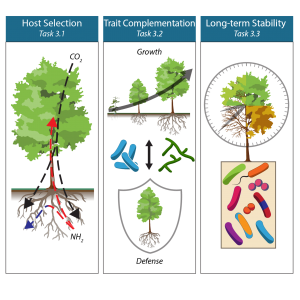Plant Microbe-Interfaces Objective 3
Understanding the dynamic relationship and extrinsic stressors that shape microbiome composition and affect host performance
In Objective 3, we will examine how the microbiome responds to the longer-term forces that result from biological and environmental stresses. Microbiome structuring is a dynamic process and we have discerned seasonal shifts in Populus-associated microbial communities on mature trees and showed that both abiotic and biotic stress can have large effects on microbial community structure. Frequent challenges by pathogens demand a robust immune repose and may require trade-offs between growth and defense. Adaptation rates of the host and the microbiome to environmental and biotic stresses differs significantly and understanding the dynamic response of the microbiome and the factors that allow maintenance of host-microbe relationships represent other key challenges in understanding the plant-microbiome interface. We expect that horizontal gene transfer will be an important evolutionary mechanism for the microbiome and can occur repeatedly over the lifetime of the host.
Objective 3 Tasks
- Task 3.1 – Identify community and population level responses of the Populus trichocarpa microbiome across natural environmental stress gradients
- Task 3.2 – Understand how microbial community composition, microbial traits, and genetic interactions mediate plant host tolerance to abiotic and biotic stress.

Objective 3 overview. Task 3.1 examines how carbon allocation leads to community membership changes. Task 3.2 examines if the response of the microbiome can complement host phenotypic tradeoffs related to plant growth and defense, and Task 3.3 examines longer-term community dynamics.


